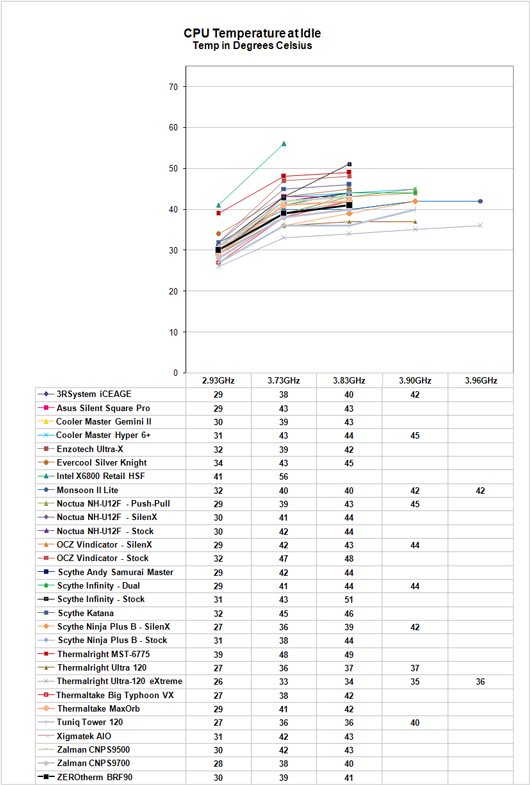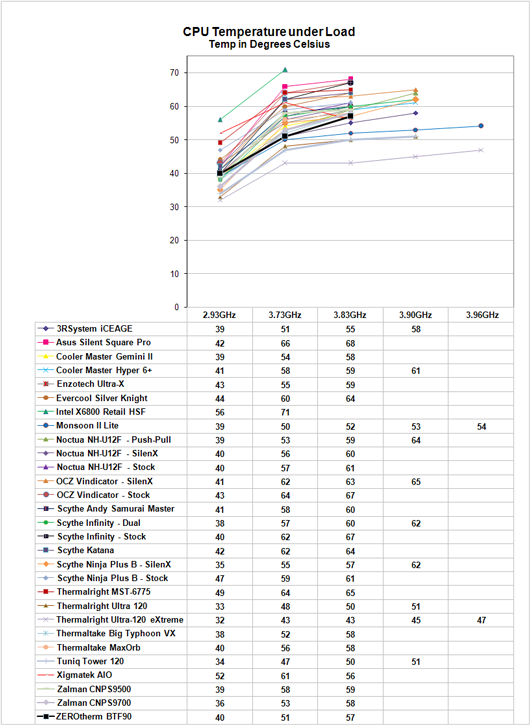ZEROtherm BTF90: Sting like a Butterfly?
by Wesley Fink on August 13, 2007 12:05 AM EST- Posted in
- Cases/Cooling/PSUs
Scaling of Cooling Performance
The BTF90 performance was average at both stock idle and stock load compared to other top coolers tested at AnandTech. Keeping in perspective that a 92mm fan drives the BTF90 compared to the 120mm fans used on most other coolers, this performance would have to be considered very good. As overclocks are raised, the ZEROtherm exhibits improved performance in the ability to cool the CPU under stress conditions.
At 2.93GHz the retail HSF is running at 41C, compared to 30C with the BTF90. This is a delta of 11C. The delta becomes greater as the overclock increases. At 3.73GHz the idle with the retail fan is 56C compared to the Ultra-X at 39C - a delta of 17C. The cooling performance of the BTF90 is much better than the Intel retail cooler at idle, but the ZEROtherm does not reach the same cooling levels measured with the Thermalrights (with a Scythe S-Flex SFF21F fan) or the stock Tuniq 120. The top Thermalright Ultra-120 eXtreme, for example, is at 33C at the same 3.73GHz.
We also need to compare cooling efficiency of the ZEROtherm BTF90 under load conditions to the retail HSF and other recently tested CPU coolers. Load testing can be very revealing of a cooler's efficiency. A basically flat line, particularly form 3.73GHz upward, indicates the cooler is still in its best cooling range. A line that is increasing rapidly indicates a cooler nearing the end of its ability to cool efficiently. Lines which parallel the best coolers over a range of values are indicate that the coolers have similar cooling efficiency.
The BTF90 is very efficient in cooling in the 2.93 GHz to 3.73 GHz overclock range. The BTF90 continues on to a highest overclock of 3.83GHz, but the cooling curve is much steeper in this area, suggesting the BTF90 is losing cooling efficiency. The BTF90 falls short of the 3.90GHz to 3.94GHz most of the top coolers in our testing have achieved, but it is also cooling with a smaller fan with a smaller output than the other coolers. It also manages this with relative quiet, as seen in the noise tests.
As stated many times, the overclocking abilities of the CPU will vary at the top, depending on the CPU. This particular CPU does higher FSB speeds than any X6800 we have tested, but the 3.90GHz top speed with the Tuniq is pretty average among the X6800 processors we have tested with Tuniq cooling. A few of the other processors tested with the best air coolers reach just over 4 GHz, but the range has been 3.8 to 4.0GHz. Stock cooling generally tops out 200 to 400 MHz lower, depending on the CPU, on the processors tested in our lab.
The BTF90 performance was average at both stock idle and stock load compared to other top coolers tested at AnandTech. Keeping in perspective that a 92mm fan drives the BTF90 compared to the 120mm fans used on most other coolers, this performance would have to be considered very good. As overclocks are raised, the ZEROtherm exhibits improved performance in the ability to cool the CPU under stress conditions.
 |
| Click to enlarge |
At 2.93GHz the retail HSF is running at 41C, compared to 30C with the BTF90. This is a delta of 11C. The delta becomes greater as the overclock increases. At 3.73GHz the idle with the retail fan is 56C compared to the Ultra-X at 39C - a delta of 17C. The cooling performance of the BTF90 is much better than the Intel retail cooler at idle, but the ZEROtherm does not reach the same cooling levels measured with the Thermalrights (with a Scythe S-Flex SFF21F fan) or the stock Tuniq 120. The top Thermalright Ultra-120 eXtreme, for example, is at 33C at the same 3.73GHz.
We also need to compare cooling efficiency of the ZEROtherm BTF90 under load conditions to the retail HSF and other recently tested CPU coolers. Load testing can be very revealing of a cooler's efficiency. A basically flat line, particularly form 3.73GHz upward, indicates the cooler is still in its best cooling range. A line that is increasing rapidly indicates a cooler nearing the end of its ability to cool efficiently. Lines which parallel the best coolers over a range of values are indicate that the coolers have similar cooling efficiency.
 |
| Click to enlarge |
The BTF90 is very efficient in cooling in the 2.93 GHz to 3.73 GHz overclock range. The BTF90 continues on to a highest overclock of 3.83GHz, but the cooling curve is much steeper in this area, suggesting the BTF90 is losing cooling efficiency. The BTF90 falls short of the 3.90GHz to 3.94GHz most of the top coolers in our testing have achieved, but it is also cooling with a smaller fan with a smaller output than the other coolers. It also manages this with relative quiet, as seen in the noise tests.
As stated many times, the overclocking abilities of the CPU will vary at the top, depending on the CPU. This particular CPU does higher FSB speeds than any X6800 we have tested, but the 3.90GHz top speed with the Tuniq is pretty average among the X6800 processors we have tested with Tuniq cooling. A few of the other processors tested with the best air coolers reach just over 4 GHz, but the range has been 3.8 to 4.0GHz. Stock cooling generally tops out 200 to 400 MHz lower, depending on the CPU, on the processors tested in our lab.










19 Comments
View All Comments
RamarC - Tuesday, August 14, 2007 - link
you spelled ali's name wrong. it's "muhammad" not "mohammed" (the prophet).mostlyprudent - Monday, August 13, 2007 - link
Nice article. As has been mentioned, I really like the low noise/high performance combo, but could live without the butterfly (although my daughter would love a pink PC w/ a window and this cooler!).Sometime ago, you mentioned the possibility of a round-up type article of all the coolers tested. I would love to see some fan testing along with that. For example, I would love to see how some of the other coolers (like the Tuniq) perform with quieter/lower output fans). I am always looking for the best combination of low noise & high performance in my builds.
Deusfaux - Monday, August 13, 2007 - link
thanx for the review, I know I had been buggin yeah about doing one on it for sometime.Looks like a pretty decent fit for the girl's rig!
n7 - Monday, August 13, 2007 - link
How's the Coolit Freezone review coming along?Wesley Fink - Monday, August 13, 2007 - link
It is coming after a couple of reviews of some new and unique water cooling products.neogodless - Monday, August 13, 2007 - link
Wow... if I could peel my girlfriend away from her MAC, I'd be asking to build her a computer right now with this heatsink!Also, I think the work you put into your articles is great, and the writing is very good, too. However, I think this particular conclusion dragged on and felt repetitive, like you felt like it had to be long for the sake of longness. Otherwise, good article and interesting product. Sometimes you don't have to be the best... to be the best choice.
Wesley Fink - Monday, August 13, 2007 - link
I reread the conclusion after your comment and basically agree. I cut some of the repeat info paragraphs and condensed the rest. All the conclusion info is still there.neogodless - Monday, August 20, 2007 - link
Ok great - I never want to be unnecessarily critical, but glad to be constructively so. (Posting this now as the new cooler article reminded me to check back.)asliarun - Monday, August 13, 2007 - link
I agree. Nice article!One (free-fart) suggestion: Please try to cater to a wider audience in your conclusions.. as it is the most important part of the article. I get the sense that you try to target the "extreme hardware-hacker/overclocker" crowd while neglecting the "value-for-money" crowd who want to extract good stable performance at reasonable prices. My inference from this article is that this cooler is a very good buy! Cheap, lightweight, silent, middle of the pack performance.. a reasonably rare combination for someone who doesn't spend more on his cooler than his CPU!
For example, I've read most of your cooler articles but still don't know which CPU+Cooler combination would give me the best performance at a given price point.